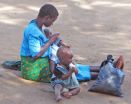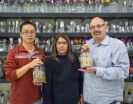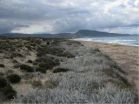(Press-News.org) (Seattle, January 30, 2013) Researchers from Benaroya Research Institute at Virginia Mason (BRI) have found that proteins in the IL-6 signaling pathway may be leveraged as novel biomarkers of multiple sclerosis (MS) to gauge disease activity and as a target for new therapies. The research, which investigated how several components involved in immune response differ between MS patient and control samples, was conducted by a team of researchers at BRI led by Dr. Jane Buckner in collaboration with Dr. Mariko Kita at Virginia Mason Medical Center and was published today in Science Translational Medicine.
Multiple sclerosis (MS) is a chronic autoimmune disease of the central nervous system affecting an estimated 400,000 people in the United States. MS is more prevalent in the Northwest region of the U.S. than almost anywhere else in the world. In the Northwest, the likelihood of being diagnosed with MS (2 in 1,000) is double that across the U.S. (1 in 1,000).
Under normal circumstances, effector T cells protect us from infection and cancer and it is the job of regulatory T cells to keep the effector T cells from attacking healthy tissue, thereby preventing autoimmune diseases such as MS. MS occurs when the immune system's effector T cells mistakenly attack myelin, which surrounds and protects the central nervous system. When the myelin is damaged, nerve impulses are not transmitted quickly or efficiently, resulting in symptoms such as numbness, weakness, vision problems, cognitive impairment or fatigue, among others. In Relapsing Remitting MS (RRMS), individuals experience episodes of active disease, which include attacks of neurologic dysfunction, followed by periods of improvement.
Buckner's group found that the T cells of RRMS patients with active disease were able to avoid suppression by regulatory T cells, while those from patients with mild or well controlled MS did not exhibit this resistance to suppression. These results suggest that the presence or absence of T cell resistance to regulatory T cells could provide patients and physicians with valuable information about an individual's disease activity level and the potential for disease progression. The researchers also discovered that resistance to T cell suppression in RRMS patients was correlated with increased sensitivity to IL-6, a protein that is produced by the immune system that has been shown to contribute to the resistance of effector T cells to suppression. Buckner's group demonstrated that the patient samples that exhibited T cell resistance to suppression also were more sensitive to IL-6. Furthermore, when the signals generated by IL-6 were blocked in these T cells, the resistance to suppression was reversed, suggesting that therapies targeting the IL-6 pathway could potentially be used to modulate T cell resistance to suppression.
"These findings are an exciting step toward better understanding why MS occurs. They will help us to better assess the degree of disease activity in MS patients and lead us to consider new therapeutic approaches for MS" noted Dr. Buckner. "Therapies that target the IL-6 pathway are already available for treatment of other autoimmune diseases and should now be tested in MS."
Future research directions will include investigation of the role of T cell resistance to suppression and IL-6 signaling in MS onset and whether the IL-6 signaling components can be used as biomarkers to predict the severity of disease at the time of diagnosis or anticipate flares and disease progression. The samples used in this study were obtained through the BRI's Translational Research Program's Biorepository. Research funding was provided by Life Sciences Discovery Fund and JDRF.
###
About Benaroya Research Institute at Virginia Mason
Benaroya Research Institute at Virginia Mason (BRI), founded in 1956, is an international leader in immune system and autoimmune disease research, translating discoveries to real-life applications. Autoimmune diseases happen when the immune system, designed to protect the body, attacks it instead. BRI is one of the few research institutes in the world dedicated to discovering causes and cures to eliminate autoimmune diseases such as type 1 diabetes, multiple sclerosis, arthritis and many others. Visit BenaroyaResearch.org or Facebook.com/BenaroyaResearch for more information about BRI, clinical studies and the more than 80 different types of autoimmune diseases.
BRI employs more than 250 scientists, physician researchers and staff with a research volume of more than $35 million in 2011, including grants from the National Institutes of Health, the National Science Foundation, the U.S. Department of Defense, JDRF, the American Heart Association and others.
BRI researchers identify biomarker and potential therapy target in multiple sclerosis
Findings offer a better understanding of the development and progression of multiple sclerosis and potential future therapeutic target
2013-01-31
ELSE PRESS RELEASES FROM THIS DATE:
3D microchip created
2013-01-31
Scientists from the University of Cambridge have created, for the first time, a new type of microchip which allows information to travel in three dimensions. Currently, microchips can only pass digital information in a very limited way - from either left to right or front to back. The research was published today, 31 January, in Nature.
Dr Reinoud Lavrijsen, an author on the paper from the University of Cambridge, said: "Today's chips are like bungalows – everything happens on the same floor. We've created the stairways allowing information to pass between floors."
Researchers ...
Disasters can prompt older children to be more giving, younger children to be more selfish
2013-01-31
A natural disaster can bring out the best in older children, prompting 9-year-olds to be more willing to share, while 6-year-olds become more selfish. Researchers at the University of Toronto, the University of Chicago, and Liaoning Normal University made this finding in a rare natural experiment in China around the time of a horrific earthquake.
A crucial difference between the two age groups emerged one month after the disaster. The 6-year-olds' willingness to share in a test measuring altruism dropped by a third, while among 9-year-olds, willingness to give to others ...
Doubt cast on Sir Bernard Lovell's brainwashing
2013-01-31
In this month's edition of Physics World, science writer Richard Corfield casts doubt on the alleged "brainwashing" of the late British astronomer Sir Bernard Lovell by the Soviets at the height of the Cold War and explains how his trips beyond the Iron Curtain laid the foundations for the easing of geopolitical tensions between the UK and the USSR.
Speaking to Lovell's son Bryan, Corfield reveals a more mundane explanation for why Lovell, who founded the Jodrell Bank telescope in the UK, fell ill on his return from the USSR in 1963.
"For me the more likely explanation ...
Gut microbes at root of severe malnutrition in kids
2013-01-31
A study of young twins in Malawi, in sub-Saharan Africa, finds that bacteria living in the intestine are an underlying cause of a form of severe acute childhood malnutrition.
The research, led by Washington University School of Medicine in St. Louis and reported Feb. 1 in the journal Science, shows how dysfunctional communities of gut microbes conspire with a poor diet to trigger malnutrition.
The discovery is bolstered by additional studies in mice, showing that gut microbes transplanted from malnourished children cause dramatic weight loss and alter metabolism when ...
Biofuels blend right in
2013-01-31
Winemakers have long known that blending different grape varietals can favorably balance the flavor characteristics of the wine they produce. In the future, makers of advanced biofuels might use a similar strategy, blending different feedstock varieties to balance the energy characteristics of the transportation fuel they produce.
A collaborative study by researchers with the U.S. Department of Energy (DOE)'s Joint BioEnergy Institute (JBEI), a bioenergy research center led by Berkeley Lab, and the Idaho National Laboratory (INL) has shown that an ionic liquid proven ...
In beef production, cow-calf phase contributes most greenhouse gases
2013-01-31
Jan. 30 2013 - Scientists have long known that cattle produce carbon dioxide and methane throughout their lives, but a new study pinpoints the cow-calf stage as a major contributor of greenhouse gases during beef production.
In a new paper for the Journal of Animal Science, scientists estimate greenhouse gas emissions from beef cattle during different stages of life. They show that, depending on which production system farmers used, beef production has a carbon footprint ranging from 10.7 to 22.6 kg of carbon dioxide equivalent per kg of hot carcass weight.
According ...
Confirmed: How plant communities endure stress
2013-01-31
PROVIDENCE, R.I. [Brown University] — Ecology is rife with predation, competition, and other dramatic "negative interactions," but those alone do not determine the course life on Earth. Organisms sometimes benefit each other, too, and according to the Stress Gradient Hypothesis, their "positive interactions" become measurably more influential when ecosystems become threatened by conditions such as drought. Ecologists have argued about the hypothesis ever since Brown University ecologist Mark Bertness co-proposed it in 1994; Bertness says a large new global meta-analysis ...
Peer pressure trumps 'thin' ideals in the media
2013-01-31
Peers exert a greater influence on teenage girls' dissatisfaction with their bodies than do thin ideals in television or social media use, according to new research¹ by Dr. Christopher J. Ferguson and colleagues from Texas A&M International University in the U.S. Their study is published online in Springer's Journal of Youth and Adolescence.
The influence of the media on body image, life satisfaction, and symptoms of eating disorders in teenage girls is a hot debate. Some experts believe that media influences on body dissatisfaction may extend to symptoms of eating disorders. ...
Lake Mead aquatic-science research documents substantial improvements in ecosystem
2013-01-31
LAS VEGAS, Nev. — Lake Mead National Recreation Area's water quality is good, the sport fish populations are sufficient, and the lakes provide important habitat for an increasing number of birds. This positive trend is documented in a new report published today that leads to a better understanding of the natural resources of Lake Mead and Lake Mohave, and the issues that may affect natural resource management of Lake Mead NRA.
"While the Lake Mead ecosystem is generally healthy and robust, the minor problems documented in the report are all being addressed by the appropriate ...
Discovery of sexual mating in Candida albicans could provide insights into infections
2013-01-31
Like many fungi and one-celled organisms, Candida albicans, a normally harmless microbe that can turn deadly, has long been thought to reproduce without sexual mating. But a new study by Professor Judith Berman and colleagues at the University of Minnesota and Tel Aviv University shows that C. albicans is capable of sexual reproduction.
The finding, published online by Nature January 30, represents an important breakthrough in understanding how this pathogen has been shaped by evolution, which could suggest strategies for preventing and treating the often serious infections ...
LAST 30 PRESS RELEASES:
Safety decision-making for autonomous vehicles integrating passenger physiological states by fNIRS
Fires could emit more air pollution than previously estimated
A new way to map how cells choose their fate
Numbers in our sights affect how we perceive space
SIMJ announces global collaborative book project in commemoration of its 75th anniversary
Air pollution exposure and birth weight
Obstructive sleep apnea risk and mental health conditions among older adults
How talking slows eye movements behind the wheel
The Ceramic Society of Japan’s Oxoate Ceramics Research Association launches new international book project
Heart-brain connection: international study reveals the role of the vagus nerve in keeping the heart young
Researchers identify Rb1 as a predictive biomarker for a new therapeutic strategy in some breast cancers
Survey reveals ethical gaps slowing AI adoption in pediatric surgery
Stimulant ADHD medications work differently than thought
AI overestimates how smart people are, according to HSE economists
HSE researchers create genome-wide map of quadruplexes
Scientists boost cell "powerhouses" to burn more calories
Automatic label checking: The missing step in making reliable medical AI
Low daily alcohol intake linked to 50% heightened mouth cancer risk in India
American Meteorological Society announces Rick Spinrad as 2026 President-Elect
Biomass-based carbon capture spotlighted in newly released global climate webinar recording
Illuminating invisible nano pollutants: advanced bioimaging tracks the full journey of emerging nanoscale contaminants in living systems
How does age affect recovery from spinal cord injury?
Novel AI tool offers prognosis for patients with head and neck cancer
Fathers’ microplastic exposure tied to their children’s metabolic problems
Research validates laboratory model for studying high-grade serous ovarian cancer
SIR 2026 delivers transformative breakthroughs in minimally invasive medicine to improve patient care
Stem Cell Reports most downloaded papers of 2025 highlight the breadth and impact of stem cell research
Oxford-led study estimates NHS spends around 3% of its primary and secondary care budget on the health impacts of heat and cold in England
A researcher’s long quest leads to a smart composite breakthrough
Urban wild bees act as “microbial sensors” of city health.
[Press-News.org] BRI researchers identify biomarker and potential therapy target in multiple sclerosisFindings offer a better understanding of the development and progression of multiple sclerosis and potential future therapeutic target



